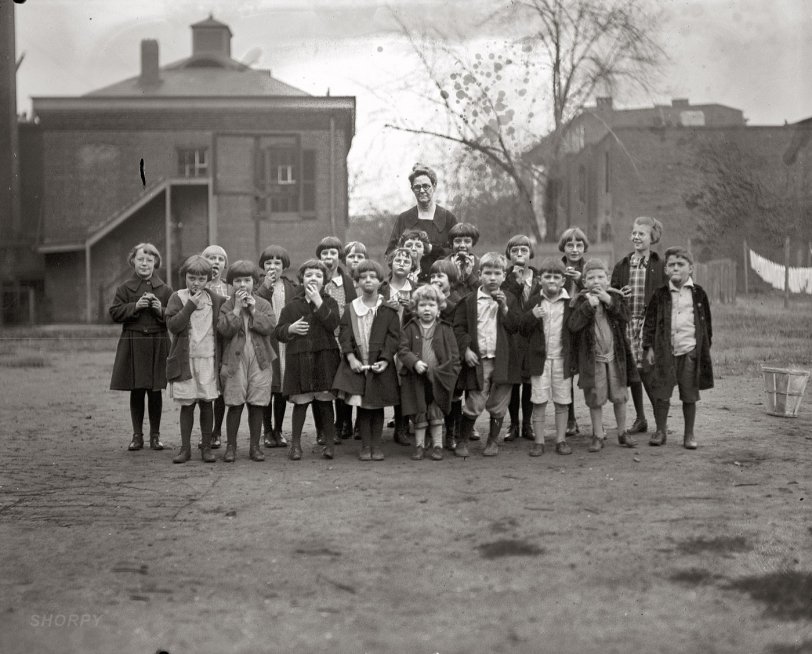


Framed or unframed, desk size to sofa size, printed by us in Arizona and Alabama since 2007. Explore now.
Shorpy is funded by you. Patreon contributors get an ad-free experience.
Learn more.

- Baldwin 62303
- Baldwin VO-1000
- Cold
- No expense spared
- Tough Guys
- Lost in Toyland
- And without gloves
- If I were a blindfolded time traveler
- Smoke Consumer Also Cooks
- Oh that stove!
- Possibly still there?
- What?!?
- $100 Reward
- Freeze Frame
- Texas Flyer wanted
- Just a Year Too Soon
- WWII -- Replacing men with women at the railroad crossing.
- Yes, Icing
- You kids drive me nuts!
- NOT An Easy Job
- I wonder
- Just add window boxes
- Icing Platform?
- Indiana Harbor Belt abides
- Freezing haze
- Corrections (for those who care)
- C&NW at Nelson
- Fallen Flags
- A dangerous job made worse
- Water Stop
Print Emporium
Apples for Orphans: 1925

November 5, 1925. "National Apple Week at Washington Orphanage." National Photo Company Collection glass negative. View full size.
Orphan questions
My mom was an orphan in Woonsocket, Rhode Island.
The hair cut is called the "Dutch Boy." It was preferred by most of the children, because if you wore long hair, you were required to keep it neat.
Most boys went to work for pay outside the orphanage in which she stayed. They were more readily adopted than girls because of this. Even if they were living in the orphanage, they worked. There were gardens to keep and trades to learn, if not at the asylum than nearby at a farm or apprenticeship. Girls learned home economics, typing, shorthand and bookkeeping at the orphanage my mother stayed in. Lessons also included "Fannie Farmer" cooking and dress-making. Scholarships for business school and nearby colleges were available to those with aptitude.
Orphans
My grandfather and some of his brothers were in an orphanage in Davenport, Iowa in the early 30's. His parents were alive but they couldn't afford to feed & clothe all their children. All my grandfather (who is an outrageous liar) would say about his time in the orphanage is that Leana Horne was also there!
Relevant Quote
"Why any kid would want to be an orphan is beyond me."
-- Miss Hannigan in the movie version of "Annie"
Girls' haircuts
I would posit the haircuts would have been for ease of care and cleanliness, not that "bobbed" hair was in fashion in 1925.
What a joy.
What a joy. Why do we grow up and lose this wonderful sense of play? This photo is a much better advertisement for apples than the "King of Fruit" one.
Grandma's place
My grandmother stayed in an orphanage for a short while, about a year I think, around 1917-1918 when her parents divorced. She never complained about the orphanage or said she was mistreated in any way. She had fond memories of the place. She was 12 and she and her friend would sneak out at night. There was an Army camp nearby and the soldiers would gather around to hear my grandmother and her friend sing for them. A very different world back then.
Do the Twist
Growing up reading Dickens, the word "orphanage" conjures up a place of poverty-stricken wretchedness. It's nice to see these kids are just...the ones with the apples just hanging in their teeth are amusing. I'm sure the matron behind them didn't know they were doing that! Another thing that stuck out to me was the eerie similarities in the girls -- dress, glasses, hair. I know that they must have all shared one barber amongst the girls and the boys, so he or she had one cut, and efficiently went with it.
Lucky, lucky girl on the left whose coat fits so well; no one else seems to be quite so well pulled-together.
Shortage of male orphans
Fascinating, this one's a keeper...been gazing at it for ages. What happened to them all? Why 17 girls and only 4 boys? Is there more chance of dying young if you give birth to girls? Is it just the haircuts or are there a fair number of sisters?
It's a hard knock life
But at least they have apples. Too cute!
























On Shorpy:
Today’s Top 5